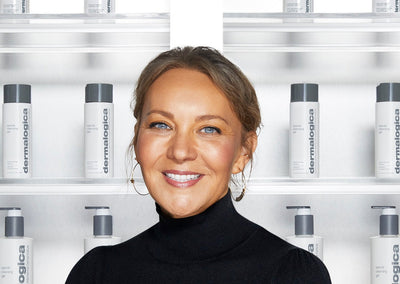4 min read
Everything you need to know about acne scarring
05/20/2022 / Last Edited 11/26/2025Get educated on the basics of acne scarring and learn how to treat scarring topically and medically.

Arguably just as infuriating as acne itself, acne scarring can come in many shapes, sizes and forms —and it can also be particularly difficult to fade. Still, there's plenty you can do at home to help mitigate and fade annoying acne scars. Here's our complete guide to everything you need to know—including the five different types of acne scars—plus tips on how best to treat them.
5 types of acne scars & how to treat them
1: hyperpigmentation
These are the dark spots that tend to linger after your pimples have cleared up. Technically, it's a discoloration of the skin that occurs after severe inflammation of the skin, which is why it's also known as post-inflammatory hyperpigmentation. You're most likely to experience this type of acne scarring if you pick or squeeze your acne—which is just one more, very important reason to keep your hands off of your face! However, if you do pop your pimple (we get it - sometimes you can't help it!), reach for brightening products with salicylic acid and hexylresorcinol like Post-Breakout Fix. Apply a small amount directly to your post-breakout mark twice a day to reduce the appearance of dark spots.
Although dark spots will usually fade over time, this process can take weeks, maybe months. However, you can help speed up the process with consistent exfoliation. Chemical exfoliation in particular, uses acids to remove dead skin cells and fade dark acne spots.
Hyperpigmentation also worsens with unprotected UV exposure, so a proper sun protection routine is key for fading dark spots (i.e. wearing Clearing Defense SPF 30 every single day, rain or shine).
2: keloid scars
These scars are easy to identify, because unlike all other types of acne scars, they are raised off of the skin. Keloid scars are raised bumps that form in the wake of the skin trying to heal itself—and in turn, producing too many skin cells. The abundance of skin cells results in a protruding bump, often pink in color.
Topical ingredients can slightly help keloid scars, but the gold standard here is a cortisone injection—which you'll have to visit a dermatologist for.
3: ice pick scars
Whether your derriere folliculitis is bacterial or not, you'll this type of acne scar earned its name because it looks as if a tiny ice pick pokes holes in the skin. Ice pick scars are small, triangular-shaped depressions in the skin which form when acne causes the skin to lose too much collagen at once. They typically form after bad bouts of cystic or hormonal acne along the cheeks and jawline.
Ice pick scars are on the severe end of the acne scar spectrum, so in order to fully treat them, you'll want to book an appointment with your dermatologist. He or she may suggest a professional chemical peel, laser resurfacing treatment, or, for extra deep scars, actually filling the individual scars using a hyaluronic acid-based injectable.
4: rolling scars
This type of acne scarring comes in groups—as in, it's not typically to see just one rolling scar. Instead, rolling scars almost look like rolling hills or waves in the ocean, with one depression fading into the next. Rolling scars often form after long-term inflammatory acne.
Similar to ice pick scars, you'll want to seek out input from your dermatologist, who will likely recommend a series of treatments such as lasers, peels or the injection of facial fillers.
5: boxcar scars
These square-shaped depressions (hence their name) often form after deep, inflamed papules and pustules clear up. Unlike rolling scars, which appear as soft grooves on the skin, boxcar scars have distinct edges, and they typically develop in a rectangular shape just like, you guess it, a box.
Boxcar scars are severe, and you will need professional help to fully heal them. Your dermatologist will likely recommend a combination of laser resurfacing treatments and fillers, which can be injected directly into the boxcar scar to raise the skin back to an even level.






